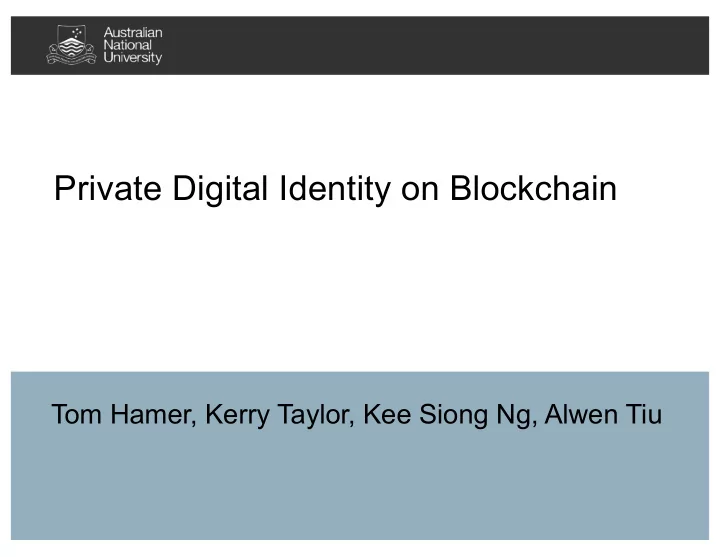

Private Digital Identity on Blockchain Tom Hamer, Kerry Taylor, Kee Siong Ng, Alwen Tiu
The Global Identity Crisis • In order to access critical services such as finance and social security, people need to have an identity • 1.5 billion people do not have an officially recognized identity • The UN sustainable development goals include “ensure a unique legal identity and enable digital ID-based services to all” 3
Problems with current identity systems • Getting a new identity document requires a previous identity document • Individuals can be linked across multiple independent uses of their identity, without consent: Linkability • Basic attributes such as address cannot easily be cancelled or changed and so a fresh identity is very hard to establish. 4
Aahaar project • Over 1.2 billion citizens have been registered • Each individual has one identity number, which creates linkability • Not interoperable with other identity systems 5
Blockchain and Identity Blockchain provides a mechanism to prove claims about identity, such as a shared ledger for the exchange of public keys, revocation of claims and proof parameters Source: Hyperledger Indy This is can be done with no central authority 6
Self-sovereign Identity • Individuals have ownership of their identity, and control over how their personal data is used for the purposes of identity • Minimal disclosure of identity (via mechanisms such as zero knowledge proof) 7
Self-sovereign Identity – ID2020 Source: ID2020 8
Self-sovereign Identity - Civic Source: Civic 9
Unique Self-sovereign identity USI means that a user can have at most one identity in a particular context, but identities cannot be linked between contexts without permission from the user. Context is defined by a shared business or organisational function which requires transactions to be linked 10
Biometrics - Background Biometrics have the capacity to produce a unique identifier for each individual However, biometric technology has a drawback - if it is stolen you can be impersonated or linked across contexts 11
How to Achieve USI Strategy: combine biometrics and cryptography to achieve USI 12
Cancelable Biometrics • Cancelable biometrics are a method for obfuscating biometric signatures when they are stored through applying a non-invertible function 13
Biometric Verification vs Identification Verification: 1-to-1 matching in biometrics. Verifies you are who you say you. Identification: 1-to-n matching in biometrics. Discovers who you are by comparing biometrics to existing biometrics in a database. 14
Issue: cancelable biometrics rely on the user trusting the other party to correctly apply the transformation/store the biometrics. Solution: we propose allowing the user to transform their own biometric themselves 15
Verifiable Claims - Background • Verifiable Claims are a mechanism to express credentials on the Web in a way that is cryptographically secure, privacy respecting, and machine-verifiable • We use verifiable claims to let the user assert ownership over an already transformed biometric signature 16
Homomorphic Signatures - Background • Homomorphic signatures allow a verifier to prove that a calculation has been done correctly without having to access the underlying data • We employ homomorphic signatures as the proof mechanism for the verifiable claims of the transformed biometrics 17
Combining Cancelable Biometrics and Homomorphic Signatures to achieve USI • The user is able to transform their own biometric using a partial discrete Fourier Transform and prove that they have transformed it correctly • The proof is via a homomorphic signature, as theorized by Gorbunov et al (STOC 2015 – 47 th ACM Symposium on the Theory of Computing) 18
19
Features of our USI System Self-sovereignty: The identity holder has complete control over storage and use of their identity. Privacy: Verifier is unable to reverse the transformation and discover the individual’s actual biometric signature. Non-linkability: if transformations have different parameters across different Service Providers, cross matching is impossible. Unique Identification: The transformation will always map back to the same identifier, subject to an error rate. Decentralisation: The trusted organisations do not communicate or agree for the Unique Identification property to hold. Biometrically Derived: t he system does not depend on individuals holding previous identity documents in order to enrol. 20
Non-linkability If transformations have different parameters across different Service Providers, cross matching is impossible. Using the framework proposed by Gomez—Barerro et al. we show that registrations in our protocol are unlinkable: 21
Further work • Blind signatures for trusted organizations • Collision probability and error rates for biometric identification at scale • Reference implementation for experimental analysis 22
Conclusion • With further work, it will be a feasible protocol for large scale privacy preserving identification • The protocol would augment existing procedures • Potential for KYC, government services, displaced persons, social media, whistleblowers, fair voting 23
For Further Reference Hamer, T. (2019). Private Digital Identity on Blockchain. Honours thesis submitted to the Australian National University, Canberra, Australia. 24
Recommend
More recommend